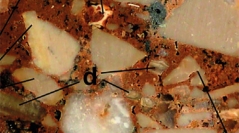

 Comptes Rendus Palevol
17 (4-5) - Pages 296-309
Comptes Rendus Palevol
17 (4-5) - Pages 296-309The Somssich Hill 2 site (Villány Mts., South Hungary) yielded one of the richest late Early Pleistocene vertebrate assemblages within the Carpathian Basin. The present paper provides a summary of all former and new taxonomical results, as well as biostratigraphical and palaeoecological conclusions, which is completed with previously unpublished sedimentological and taphonomical observations on the locality. The bulk of the fauna can be referred to the Mimomys savini–Mimomys pusillus Biozone in the Biharian (MQ1), whereas a few specimens suggest an older age, namely the Mimomys pliocaenicus Biozone in the late Villanyian (MN17). The bones were affected by only a short-distance aquatic transport, thus they represent a parautochtonous and relatively unaltered assemblage. Consequently, the material was considered here as a reliable base for reconstructing the direct palaeoenvironment of the cavity. The entire section was divided here to five different palaeoecological units based on the small vertebrate fauna.
Late early Pleistocene, Epivillafranchian turnover, Small vertebrates, Sedimentology, Taphonomy, Palaeoecology, ESR dating